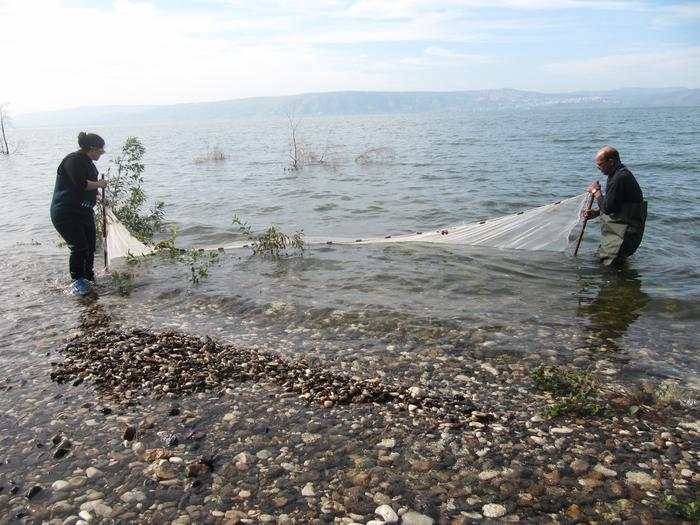Hebrew University of Jerusalem, Israel – A new study led by Dr. Roni Tadmor-Levi in the group of Prof. Lior David and a team of researchers from the Hebrew University of Jerusalem and Tel Aviv University, has shed new light on Israel’s freshwater fish biodiversity. The study, initiated by the Israel Nature and Parks Authority, focused on DNA barcoding, has unveiled intriguing insights into the unique populations and species composition in the region, their genetic distinctiveness, with implications for conservation efforts.

Credit: James Shapira from the Fisheries Division of the Ministry of Agriculture, Israel
Hebrew University of Jerusalem, Israel – A new study led by Dr. Roni Tadmor-Levi in the group of Prof. Lior David and a team of researchers from the Hebrew University of Jerusalem and Tel Aviv University, has shed new light on Israel’s freshwater fish biodiversity. The study, initiated by the Israel Nature and Parks Authority, focused on DNA barcoding, has unveiled intriguing insights into the unique populations and species composition in the region, their genetic distinctiveness, with implications for conservation efforts.
Israel’s geographical positioning as a continental bridge has endowed its freshwater fish fauna with a tapestry of species, originating from Africa, Asia, and Europe. Often, these species are endemic or represented by unique populations adapted to live at the peripheries of their distribution ranges. However, freshwater habitats, especially in arid regions, including parts of Israel, have been facing substantial pressures and disturbances, threatening biodiversity.
To address these challenges, a reliable inventory of species and populations can direct what and how to protect Israel’s biodiversity. The research team employed DNA barcoding, a cutting-edge technique that complements traditional species identification methods, to create a comprehensive database for Israel’s freshwater fish. Over 200 specimens from the scientific collections stored at the Steinhardt Museum of Natural History representing more than 28 species underwent DNA barcoding analysis, yielding 71 distinct barcodes, with an astonishing 37% identified as new. This discovery underscores the unparalleled uniqueness of fish populations in Israel.
While most species showed alignment between morphological and molecular identifications, the study identified discrepancies in five genera, and lead to significant reconsiderations for 12 different species. Notably, the research suggests the consolidation of species and proposes taxonomic revisions. Among these proposals, Acanthobrama telavivensis (Lavnun ha’yarkon) is suggested as a junior synonym for Acanthobrama lissneri (Lavnun lisnner), and the potential splitting of Garra nana (Yableset) into two distinct species, alongside establishing the presence of Garra jordanica and not Garra rufa (Red garra) in Israel and the near region.
Moreover, the study challenges previously reported classifications of certain species, such as Pseudophoxinus kervillei (Lavnunit ha’galil), suggesting discrepancies from neighboring regions. Similarly, in the case of Oxynoemacheilus (loach) species, combining DNA barcoding with morphology revisited how many and which species are in Israel.
Of significant importance is the revelation regarding Aphanius mento (Pearl-spotted killifish), indicating the likelihood of it being a species complex due to genetic and geographic disparities.
This comprehensive barcoding database not only prompts significant reconsiderations of species within the region but also identifies biodiversity ‘hotspots,’ notably the Sea of Galilee and the Beit She’an valley streams.
The implications of this study extend beyond taxonomy, advocating for a deeper understanding of fish species and their ecological dynamics. This research is poised to fuel further investigations into the region’s fish species and their habitats, strengthening efforts towards monitoring and conserving Israel and the region’s freshwater fish biodiversity.
According to Dr. Noam Leader (Director of the Ecology Department) and Dr. Dana Milstein (Aquatic Ecologist) of the Science Division of the Israel Nature and Parks Authority, the Parks Authority works to preserve the diversity of fish fauna which are characteristic and unique to Israel, including 13 species that are protected species by law. The current study clarifies which species exist in Israel and makes it possible to better assess their distribution, and more importantly to identify those that are at risk. This information has great concervation value since it enables the Parks Authority to promote actions to protect endangered species (for example, the establishment of captive breeding centers), to adjust the management of the aquatic habitats within the boundaries of nature reserves, as well as to emphasise the river rehabilitation activities that the Parks Authority is carrying out. The combination of knowledge and actions is what will ensure better protection of Israel’s unique fish comminuty.
Journal
Ecology and Evolution
DOI
10.1002/ece3.10812
Method of Research
Data/statistical analysis
Subject of Research
Animals
Article Title
Revisiting the Species List of Freshwater Fish in Israel Based on DNA Barcoding
Article Publication Date
20-Dec-2023




